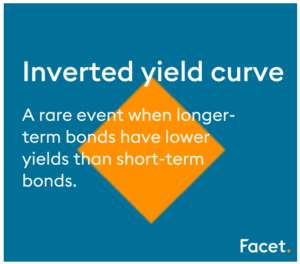
The information provided is based on the published date.
Key takeaways
- An inverted yield curve occurs when short-term bond yields exceed long-term bond yields
- May signal economic instability and a potential recession
- The yield curve has inverted 7 times in the last 50 years
- Influenced by factors such as the Fed’s monetary policy and investor expectations
- Experts have long debated the phenomenon's feasibility as a market predictor
A yield curve inverts when short-term bond yields outpace their long-term counterparts, often raising alarms of an impending recession.
Understanding how the inverted yield curve works is important for investors, as it reflects a significant shift in market sentiment and the economic outlook.
Here’s a breakdown of how this phenomenon works, its history, and its viability as an economic indicator.
Understanding the inverted yield curve
An inverted yield curve occurs when short-term bond yields surpass long-term bond yields, signaling potential economic turbulence ahead.
This atypical situation is usually triggered by a sudden surge in demand for long-term bonds, causing their yields to decrease faster than their short-term counterparts.
The inversion of the yield curve is often considered a harbinger of economic distress, spurring a shift towards risk-averse investment behaviors.
Investors may see the following:
- A decrease in profit margins for businesses that rely on the difference between short-term borrowing and long-term lending
- Stricter credit conditions
- Reduced lending activity
The normal yield curve
Before we delve into the inverted yield curve phenomenon, let’s first understand its counterpart, the normal yield curve.
Characterized by an upward slope from left to right, a normal yield curve signifies:
- Stable economic conditions
- A regular economic cycle
- Anticipation of rising interest rates in the future
- A burgeoning economy
- An optimistic market outlook
The inverted yield curve

The inverted yield curve paints a contrasting picture. Here, short-term debt instruments exhibit higher yields compared to their long-term peers. This inversion is often linked to the anticipation of decreasing longer-term interest rates, signaling a looming recession.
The inversion is attributed to the scenario where long-term interest rates become lower than short-term interest rates, typically resulting from increased demand for longer-term bonds over short-term bonds. This curve inversion indicates that short-term risks are higher than long-term ones, suggesting a possible recession ahead.
Factors contributing to yield curve inversion
The yield curve inversion is the product of various factors, with the Federal Reserve’s monetary policy and investor expectations the most prominent.
The Fed, through its actions and targets for short-term interest rates, can significantly influence the shape of the yield curve. Its monetary policy can shape market expectations of future rates, potentially leading to a yield curve inversion.
Federal Reserve's role
The Fed controls the interest rate landscape by establishing the federal funds rate—the target interest rate for overnight lending between banks. This target rate, along with the Fed’s decisions, impacts the interest rates set by banks and other lenders.
The Fed has the potential to contribute to a yield curve inversion by elevating short-term interest rates, which could lead to a flattening or even inversion of the yield curve.
Investor expectations
Investor expectations, reflected in bond traders’ buying and selling behavior, influence bond interest rates with varying maturities.
Lower expectations for economic growth and inflation can lead investors to anticipate lower future interest rates, causing long-term bond rates to dip below short-term bond rates and resulting in inversion. As a result, bond prices can be affected by fluctuations in the yield curve.
This anticipation, coupled with a surge in demand for long-term bonds, can tilt the balance and result in a situation where the yield curve inverts, leading to a treasury yield curve inversion.
Historical instances of inverted yield curves
History provides compelling evidence of the predictive power of inverted yield curves.
The first instance of an inverted yield curve was observed just prior to the Great Depression of 1929, stemming from the Federal Reserve’s decision to increase interest rates in order to mitigate stock market speculation.
Consequently, investors started selling long-term bonds, which created a knock-on effect, causing yields to climb and prices to drop. The subsequent yield curve inversion cued the beginning of the Great Depression, which continued for more than a decade.
Over the past 50 years, the yield curve has inverted seven times, with the period between an inverted yield curve and the onset of a recession ranging from 6 to 24 months. This historical pattern underscores the remarkable accuracy of inverted yield curves in predicting recessions, with only one false signal since 1955.
Debating the relevance of inverted yield curves
Despite the historical precedence, the predictive power of inverted yield curves continues to be a subject of intense debate among economists and financial analysts. While some fervently believe in its accuracy, others question its reliability as an economic forecaster, especially when compared to the most reliable leading indicators.
Supporters' viewpoints
Supporters, such as Campbell Harvey, a finance professor at Duke University, and Richard McGuire, a fixed income expert, base their affirmations on the historical evidence of inverted yield curves accurately predicting every recession since the fifties. They argue that inverted yield curves have consistently indicated an anticipation of lower future rates and a market expectation of an impending economic slowdown.
Skeptics' viewpoints
On the flip side, skeptics argue that an inverted yield curve may not possess predictive capability due to its infrequent occurrence and indication of near-term riskiness compared to the long-term.
They suggest that an inverted yield curve may not forecast economic outcomes but rather signal future Federal Reserve rate policy. They also caution that an inverted yield curve may not invariably lead to a recession.
Whether you're a supporter or skeptic, it's wise to prepare for a possible recession. Preparing for an economic downturn involves a two-pronged approach: adopting sound financial planning strategies and making wise investment decisions.
Global inverted yield curves
Inverted yield curves don’t just happen in the US. The global phenomenon has most notably affected Japan’s stock market, banks, and insurers. Instances of such inversions have also been documented in 29 other countries.
Emerging economies like Brazil and India have taken proactive measures, such as raising key interest rates, to mitigate the economic effects of yield curve inversions.
Final word
Inverted yield curves have proven to be a compelling indicator of economic health. Despite the debates around its predictive power, historical evidence underscores their significance. While we can’t control the economic trends, understanding this phenomenon helps us focus on preparing for potential economic downturns with informed financial planning.
Facet
Facet Wealth, Inc. (“Facet”) is an SEC registered investment adviser headquartered in Baltimore, Maryland. This is not an offer to sell securities or the solicitation of an offer to purchase securities. This is not investment, financial, legal, or tax advice. Past performance is not a guarantee of future performance.


